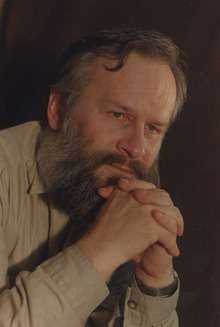Robert G. Bednarik
Robert G. Bednarik (born 6 April 1944 in Vienna) is an Australian prehistorian and cognitive archeologist.

Robert Bednarik moved from Austria to Australia in 1967. Bednarik, who considers himself an autodidact, is an expert in the fields of rock art and paleolithic portable art. He conducts experimental archeology and edits four scientific journals.
According to Bednarik he has published more than 1300 scientific articles since 1965. He is professor at the International Centre of Rock Art Dating (ICRAD)[1] at the Hebei Normal University in Shijiazhuang (China).[2]
Bednarik's principal research interest is the origins of the human ability to create constructs of reality; consequently his research focusses on the origins of art,[3] language, and the development of hominid technology.[4]
Publications (selection)
- Books
- Rock art science: the scientific study of palaeoart. IFRAO-Brepols Series 1, Brepols, Turnhout 2001, ISBN 2-503-99124-6.
- The human condition. Springer, New York 2011, ISBN 978-1-4419-9352-6.
- Creating the human past. Archaeopress, Oxford 2013, ISBN 978-1-905739-63-9.
- (Hrsg.): The origins of modern human behaviour. Nova Press, New York, NY. 2013, ISBN 978-1-62257-901-3; darin S. 1–58: The psychology of human behaviour
- The first mariners. Research India Press, New Delhi 2014, ISBN 978-93-5171-007-3.
- Articles
- On the cognitive development of hominids. In: Man and Environment 15(2), 1990, S. 1–7.
- Palaeoart and archaeological myths. In: Cambridge Archaeological Journal 2(1), 1992, 27–43.
- Concept-mediated marking in the Lower Palaeolithic. In: Current Anthropology 36(4), 1995, 605–634.
- The ‘australopithecine’ cobble from Makapansgat, South Africa. South African Archaeological Bulletin 53: 1998, 4–8.
- The dating of rock art: a critique. In: Journal of Archaeological Science 29(11), 2002, 1213–1233.
- The oldest surviving rock art: a taphonomic review. In: Origini 24, 2002, 335–349.
- The earliest evidence of palaeoart. In: Rock Art Research 20 (2), 2003, 89–135.
- Children as Pleistocene artists. In: Rock Art Research 25 (2), 2008, 173–182.
- The domestication of humans. In: Anthropologie 46(1), 2008, 1–17.
- The mythical Moderns. In: Journal of World Prehistory 21(2), 2008, 85–102.
- An aetiology of hominin behaviour. In: HOMO — Journal of Comparative Human Biology 63, 2012, 319–335; doi. 10.1016/j.jchb.2012.07.004
- The tribology of cupules. In: Geological Magazine 152(4), 2015, S. 758–765; doi:10.1017/S0016756815000060
References
- http://www.rockartdating.com/en/page/html/company.php
- www.ifrao.com
- Robert G. Bednarik: The earliest evidence of palaeoart. In: Rock Art Research 20 (2):2003, 89–135.
- Robert Bednarik: The first mariners. In: The American Neptune 61 (3): 2002, 317–324.
External links
- Homepage of Robert G. Bednarik
- complete list of publications at www.ifrao.com
- Robert G. Bednarik at academia.edu
- Robert G. Bednarik at researchgate.net